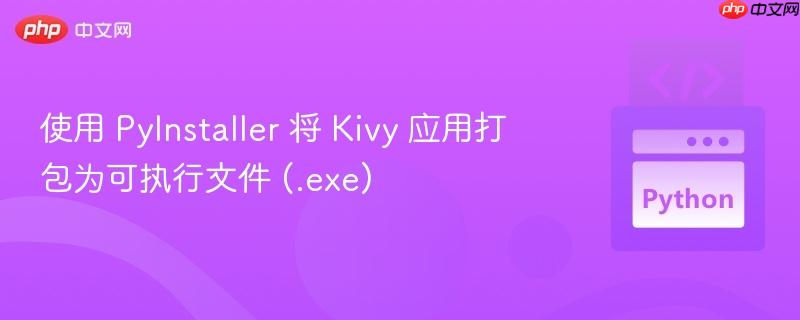
本文档旨在指导开发者如何使用 PyInstaller 工具将基于 Python 和 Kivy 框架开发的应用程序打包成独立的可执行文件(.exe)。我们将详细介绍 PyInstaller 的安装、`.spec` 文件的创建与配置、版本文件的编写,以及最终的编译步骤,帮助你解决打包过程中可能遇到的问题。
将 Python 和 Kivy 应用打包成可执行文件,可以使用 PyInstaller 这个强大的 Python 库。 它能够将 Python 脚本及其依赖项打包成一个独立的 .exe 文件,方便用户在没有 Python 环境的机器上运行。
首先,你需要安装 PyInstaller。打开你的终端或命令提示符,并输入以下命令:
pip install pyinstaller
这条命令会从 Python 包索引(PyPI)下载并安装 PyInstaller 及其依赖项。
.spec 文件是 PyInstaller 的配置文件,用于指定打包过程中的各种参数,例如主程序入口、依赖项、资源文件等。
生成 .spec 文件
在你的项目目录下,打开终端或命令提示符,并输入以下命令:
pyi-makespec your_main_file.py
将 your_main_file.py 替换为你的主程序文件名。这条命令会在当前目录下生成一个名为 your_main_file.spec 的文件。
编辑 .spec 文件
使用文本编辑器打开生成的 .spec 文件。你需要修改以下几个关键部分:
Analysis 部分:
EXE 部分:
一个典型的 Kivy 应用的 .spec 文件可能如下所示:
# -*- mode: python ; coding: utf-8 -*-
from kivy_deps import sdl2, glew
from kivy.tools.packaging.pyinstaller_hooks import get_deps_minimal, get_deps_all, hookspath, runtime_hooks
block_cipher = None
a = Analysis(
['../your_main_file.py'],
pathex=[],
datas=[("../your_folder","your_folder"),("../your_file.ext",".")],
hookspath=[],
hooksconfig={},
runtime_hooks=[],
win_no_prefer_redirects=False,
win_private_assemblies=False,
cipher=block_cipher,
hiddenimports=["tkinter"],
noarchive=False
)
pyz = PYZ(a.pure, a.zipped_data, cipher=block_cipher)
exe = EXE(pyz,
a.scripts,
a.binaries,
a.zipfiles,
a.datas,
name='YourAppName',
version="version.txt",
*[Tree(p) for p in (sdl2.dep_bins + glew.dep_bins)],
debug=False,
strip=False,
upx=True,
runtime_tmpdir=None,
console=False,
icon='../your_icon.ico')版本信息文件用于设置应用程序的版本号、公司名称、版权信息等。创建一个名为 version.txt 的文件,并按照以下格式填写:
# UTF-8
#
# For more details about fixed file info 'ffi' see:
# http://msdn.microsoft.com/en-us/library/ms646997.aspx
VSVersionInfo(
ffi=FixedFileInfo(
# filevers and prodvers should be always a tuple with four items: (1, 2, 3, 4)
# Set not needed items to zero 0.
filevers=(1, 0, 0, 0),
prodvers=(1, 0, 0, 0),
# Contains a bitmask that specifies the valid bits 'flags'r
mask=0x3f,
# Contains a bitmask that specifies the Boolean attributes of the file.
flags=0x0,
# The operating system for which this file was designed.
# 0x4 - NT and there is no need to change it.
OS=0x4,
# The general type of file.
# 0x1 - the file is an application.
fileType=0x1,
# The function of the file.
# 0x0 - the function is not defined for this fileType
subtype=0x0,
# Creation date and time stamp.
date=(0, 0)
),
kids=[
StringFileInfo(
[
StringTable(
u'040904B0',
[StringStruct(u'CompanyName', u'Your company name'),
StringStruct(u'FileDescription', u'Your Filename'),
StringStruct(u'FileVersion', u'Your version number'),
StringStruct(u'InternalName', u'Your app name'),
StringStruct(u'LegalCopyright', u'Copyright (c) your company name'),
StringStruct(u'OriginalFilename', u'YourApp.exe'),
StringStruct(u'ProductName', u'YourApp'),
StringStruct(u'ProductVersion', u'4.2.0')])
]),
VarFileInfo([VarStruct(u'Translation', [1033, 1200])])
]
)根据你的应用信息修改文件中的字段。
完成 .spec 文件的配置后,就可以运行 PyInstaller 进行打包了。在终端或命令提示符中,输入以下命令:
pyinstaller your_main_file.spec
将 your_main_file.spec 替换为你的 .spec 文件名。PyInstaller 会根据 .spec 文件的配置,分析你的代码,收集依赖项,并将它们打包成一个可执行文件。
打包完成后,会在你的项目目录下生成两个文件夹:dist 和 build。可执行文件位于 dist 文件夹中。根据 .spec 文件的配置,你可能会得到一个单独的可执行文件,或者一个包含所有依赖项的文件夹。
pip install -U kivy_deps.sdl2 kivy_deps.glew
使用 PyInstaller 可以方便地将 Python 和 Kivy 应用打包成可执行文件。通过正确地配置 .spec 文件,你可以控制打包过程的各个方面,确保你的应用能够顺利运行。 记住要仔细检查依赖项、资源文件和路径,并根据你的应用需求调整 .spec 文件的配置。
以上就是使用 PyInstaller 将 Kivy 应用打包为可执行文件 (.exe)的详细内容,更多请关注php中文网其它相关文章!

每个人都需要一台速度更快、更稳定的 PC。随着时间的推移,垃圾文件、旧注册表数据和不必要的后台进程会占用资源并降低性能。幸运的是,许多工具可以让 Windows 保持平稳运行。

Copyright 2014-2025 https://www.php.cn/ All Rights Reserved | php.cn | 湘ICP备2023035733号